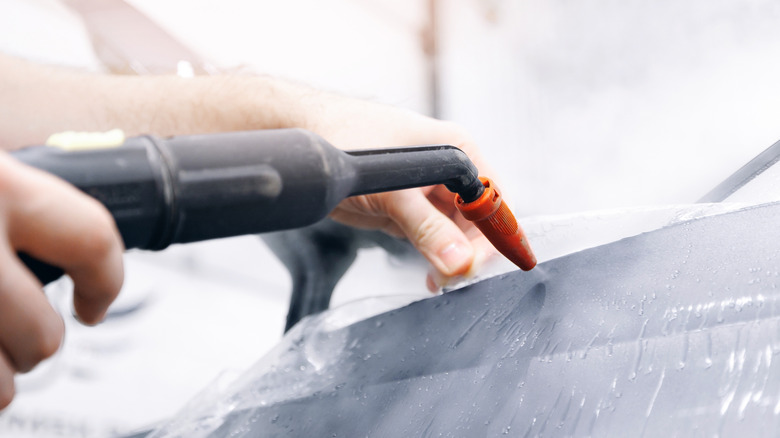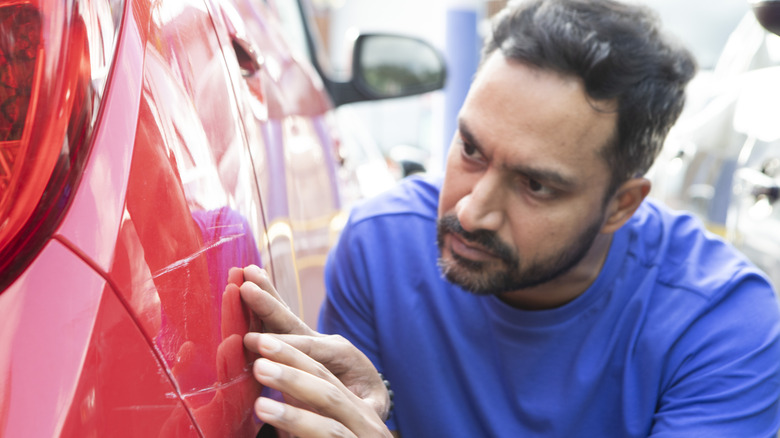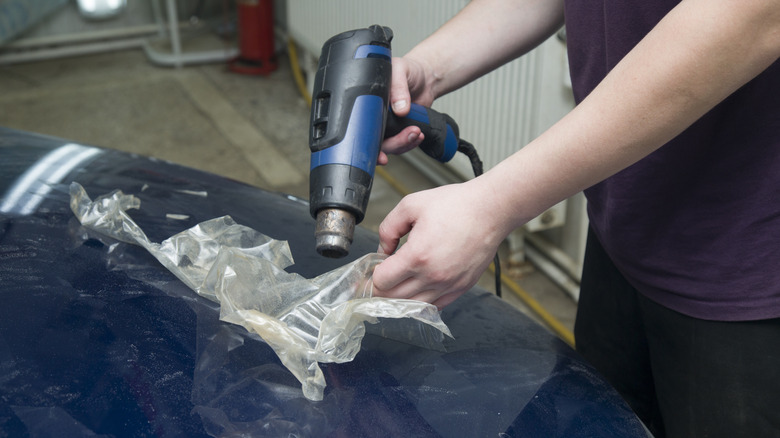Why You Should Avoid The Compressed Air Method When Removing The Wrap On Your Car
We may receive a commission on purchases made from links.
When it comes to giving your car a little more pizazz, a full paint job is one of the simplest upgrades you can consider. Just like professional detailing and changing your oil, giving your car a fresh coat of paint works like preventative maintenance. It protects the car's exterior from corrosion and keeps it looking newer for longer, which is a plus in its resale value. However, despite improving your car's look, a fresh paint job can be expensive and permanent.
The good news is that if you want to upgrade your older vehicle without going through the hassle of repainting, you can give it a major facelift with a vinyl wrap. It's a temporary way of dressing your car with a new shade and color with minimal spending. In fact, if you want to hide paint imperfections or protect your car's original paint against scratches, vinyl wrapping will give your car a one-of-a-kind feel. But (unfortunately) vinyl wraps have a limited lifespan of about five to seven years, depending on several factors. Sometimes, a wrap can degrade even faster when exposed to harsh conditions (say, extreme sunlight and cold), and when this happens, you'll have to peel it off.
Now, if you want to remove the wrapping, you can let a professional handle the task. However, you may decide to do it yourself, especially if you want to save a few hundred dollars. One DIY hack is the compressed air method, where you make a small hole between the vinyl wrap and your car's body and blow in compressed air to create a giant bubble. But before you go down that route, it's best to consider the possible side effects. What should be a money-saving shortcut could end in costly repairs to your vehicle's paint and bodywork.
What could go wrong with the compressed air method?
Removing car wraps using the compressed air method is not a super-complicated task. But if you're not careful, a lot can go wrong. That's why it's crucial that you have a complete understanding of the risks before you proceed. For instance, the high-pressure air can sometimes lift or peel away sections of the vehicle's paint along with the vinyl. This damage means you're not just removing the vinyl wrap but also looking at a fresh paint job, which can be expensive. Even worse, you could end up with damaged panels that will cost thousands of dollars to repair.
There's also the issue of inconsistent results. Since the process is uncontrolled, the force tends to tear the wrap material in random and uneven patterns. That means some sections will be left peeled, and others will still be stuck. So, instead of saving time removing the wrap, you'll be left scraping off pieces and bits, defeating the whole purpose of proceeding with this DIY route. Consequently, the vinyl can also warp or distort due to the sudden bursts of air pressure. This will lead to rough edges or torn sections, which may complicate the removal process.
How to safely remove a car wrap?
If you want to avoid this DIY route altogether, there are safer alternatives for removing a car wrap without damaging the original paint. Heating is one of the most reliable ways to safely and effectively remove a vinyl wrap. All you need is a heat gun (or a hairdryer), and gently heat the vinyl to approximately 65 degrees. This will soften the adhesive, allowing the wrap to peel away cleanly without damage to your paint. While at it, you'll want to pull the wrap slowly at a 20 to 40-degree angle as you work. Not only will this reduce the chance of tearing the vinyl, but it will also minimize the amount of adhesive left behind.
It's worth noting that some adhesive residue might remain on the car's surface even after removing the wrap using heat. Of course, this might create some concerns, especially when it comes to your car's look. Luckily, with adhesive removers like Goo Gone Automotive from Amazon, you can easily remove adhesive residue left behind without interfering with your vehicle's paint or exterior finish. A word of caution, though, when using such strong adhesive removals, it's best that you wear gloves. You'll also want to avoid using excessive amounts at once, as it can damage your vehicle's paint.


